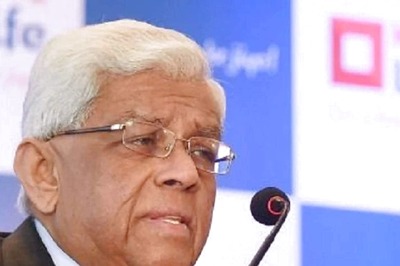
views
The death of Bengaluru cyclist Anil Kadsur at the age of 45 due to a heart attack has sparked discussions on the dangers of extreme physical exertion in terms of exercises and activities.
“How much exercise is too much exercise?” is the question many are contemplating after reading about Kadsur’s death. Medical experts and practitioners, however, say “excess of everything is bad, including exercise”.
Although the exact cause of Kadsur’s death, who called himself as a “strength and conditioning coach”, has not been disclosed publicly, he was a renowned cyclist who served as a source of inspiration for enthusiasts across the country.
According to Kadsur’s profile on Instagram – on which he last posted on October 2023 – he covered more than 2.71 lakh km as “lifetime kilometers” via cycling.
Fondly known as ‘century cyclist’, ‘cycle yogi’ or ‘cycle guru’, Kadsur recently took to social media to announce his achievement of completing 100 km cycle rides every day for 42 consecutive months. According to a Times of India report, he was hospitalised due to a feeling of uneasiness on the same day he shared his achievement on social media.
‘Listen to your Body’
While cycling is generally considered a healthy form of exercise, experts cautioned against “excess” workouts.
Experts warned that engaging in physical activities such as cycling can strain the heart. Factors such as existing heart conditions, genetic predisposition, overexertion, dehydration, or extreme weather conditions could increase the risk of a heart attack while cycling.
They advised that regular exercise is crucial for maintaining health, but it’s equally important to listen to your body. It is important to undergo routine health check-ups and be aware of any warning signs or symptoms – even if you are extremely passionate about certain physical activity be it cycling, working out in gyms, aerobic exercise, or marathons.
How Could Cycling Go Wrong?
According to Dr Ajay Kaul, Chairman, Cardiac Sciences at Fortis Hospital, Noida, cycling is indeed a good form of exercise that promotes cardiovascular health, strengthens muscles, and improves overall well-being.
Similarly, Dr Sudhir Kumar, neurologist at Apollo Hospitals, Hyderabad, who himself is a runner, labelled cycling as an “excellent aerobic exercise, which is gentler on the knees too”.
Kumar said it is preferred by many as their go-to exercise for improving cardiorespiratory fitness. However, an excessive amount of cycling can be detrimental to health.
Kumar explained a scientific phenomenon called a “dose-response” between the amount of exercise and the risk of cardiovascular diseases (CVDs), and this response is usually U-shaped.
This means that initially, as a passive person starts exercising, the risk of CVDs declines. The risks continue to decline as the duration and intensity of exercise increase until a “saturation point” is reached. At this point, the beneficial effects of exercise plateau off, and if the person exercises more, the risks of CVDs start increasing.
“Therefore, a person should exercise within their limits,” Kumar warned while sharing his observation that Kadsur was cycling 100 km per day for 42 months daily, without a day’s break.
“Not only was the amount of cycling excessive, but not taking a rest day was also not advisable. Research has shown that people who exercise on all 7 days a week have a higher risk of CVDs and a higher risk of premature death”.
Kumar, who is also a marathon runner himself, said people doing vigorous endurance exercises such as long-distance cycling or running should take one day of rest a week for recovery.
Additionally, Kaul from Fortis said sudden cardiac events can also occur due to underlying heart abnormalities that may not have been previously detected.
Compromised Sleep Could Kill
Dr Rajeev Jayadevan, a senior gastroenterologist in Kochi, pointed out concerns related to sleep quantity and quality after noticing the timings of his cycling.
“A risk factor that was frequently neglected was sleep. According to media reports, cyclists who succumbed used to get up at 2:30 am every day to complete 100 km of cycling. It is not a recommended healthy lifestyle”.
Jayadevan, who is also a convener of the scientific committee and president of the Indian Medical Association, Kochi, explained that lack of sleep creates several metabolic changes within the body including an increase in insulin resistance, which drives multiple cardiovascular risk factors.
“While losing a single night’s sleep would not affect much, habitually losing sleep puts one at great risk,” he said while adding that studies have shown that people who sleep less than six hours have a higher risk of heart attack and stroke.
How Much Exercise Can One Do?
The amount of exercise needed varies from person to person based on factors such as age, fitness level, underlying health conditions and lifestyle.
Kaul from Fortis said, generally, adults should aim for at least 150 minutes of moderate-intensity aerobic activity or 75 minutes of vigorous-intensity aerobic activity per week, along with muscle-strengthening activities on two or more days a week.
“However, it’s essential to consult with a healthcare professional to determine the appropriate exercise regimen based on individual health goals and considerations,” he advised.
Jayadevan explained that due to the increase in the use of technology, human beings are required to increase physical activity to protect themselves from getting chronic diseases.
“We know sedentary status increases the risk of multiple diseases such as diabetes, hypertension, cancer, heart diseases and more. But how much physical activity is needed is an important question.”
Published scientific evidence in the European Journal of Preventive Cardiology, showed that an active lifestyle that involves step counts of over 3,000 steps per day will start producing discernible benefits after several years such as a reduction in the total risk of death, and a reduction in the total risk of cardiovascular diseases.
“As the daily step count increases, there is an incremental improvement,” Jayadevan explained while adding that “this does not mean that a very high level of exercise means the person will live indefinitely long. Excess of anything is detrimental whether it is exercise, food, medicine, or sleep”.
Look Out for These Signs
Engaging in activities that involve physical strain, whether it’s a passion like cycling or a profession involving labour-intensive work, requires awareness of various factors to ensure safety and well-being.
These include staying adequately hydrated, maintaining proper nutrition, getting sufficient rest and recovery, using appropriate protective gear, recognising and addressing signs of fatigue or overexertion, and undergoing regular health screenings to detect any underlying health conditions that may pose risks during physical activity.
“Additionally, individuals should be mindful of environmental factors such as temperature extremes and pollution levels that can impact health and performance during physical exertion,” Kaul said.
According to Dr Praveen Sadarmin, consultant cardiologist, at Narayana Health City, Bengaluru, people should be mindful of excessive exertion, especially in extreme weather conditions or high-altitude environments, which can strain the heart and precipitate a cardiac event.
“Furthermore, individual genetic predispositions and lifestyle habits such as smoking or poor dietary choices can also increase susceptibility. Even the fittest individuals can be at risk of sudden cardiac death from arrhythmias”.
Sadarmin advised that cyclists must listen to their bodies, maintain a balanced exercise regimen, and undergo regular health screenings. “All professional athletes including cyclists should undergo mandatory clearance from their doctor. Ultimately, while cycling promotes heart health, understanding individual risk factors and practicing caution is vital for maintaining overall well-being”.




















Comments
0 comment